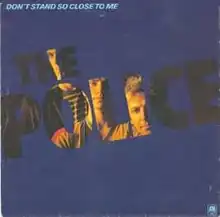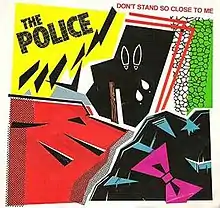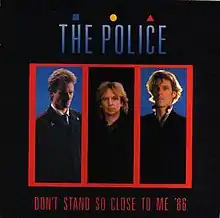Don't Stand So Close to Me
"Don't Stand So Close to Me" is a hit song by the rock band the Police, released in September 1980 as the lead single from their third studio album Zenyatta Mondatta. It concerns a teacher who has a sexual relationship with a student, which in turn is discovered.
| "Don't Stand So Close to Me" | ||||
|---|---|---|---|---|
 1980 single cover | ||||
| Single by the Police | ||||
| from the album Zenyatta Mondatta | ||||
| B-side |
| |||
| Released | 19 September 1980 | |||
| Recorded | 1980 | |||
| Genre | ||||
| Length | 4:02[1] | |||
| Label | A&M (AMS 7564) | |||
| Songwriter(s) | Sting | |||
| Producer(s) | ||||
| The Police singles chronology | ||||
| ||||
| Alternative cover | ||||
 American single picture sleeve | ||||
| Music video | ||||
| "Don't Stand So Close to Me" on YouTube | ||||
| "Don't Stand So Close To Me (Christmas Version)" on YouTube | ||||
The band's third No. 1 on the UK Singles Chart, it was also the best selling single of 1980 in the UK selling 808,000 copies in 1980 alone.[2][3] The song also charted in the top ten in Australia, Canada and the US. The Police won the 1982 Grammy Award for Best Rock Performance by a Duo or Group with Vocal for this song.[4]
Background
The music and lyrics of the song were written by the lead vocalist of the Police, Sting. The song deals with the mixed feelings of lust, fear and guilt that a school teacher has for a student and the fallout when the inappropriate relationship is discovered by other adults. The line "Just like the old man in that book by Nabokov" alludes to Vladimir Nabokov's novel Lolita (1955), which covers somewhat similar issues.[5] The line was criticised for rhyming "shake and cough" with Nabokov.[6] Sting replied, "I've used that terrible, terrible rhyme technique a few times."[6]
Before joining the Police, Sting had previously worked as an English teacher. He referred to the song's story progression as "the teacher, the open page, the virgin, the rape in the car, getting the sack."[6]
In 1993, however, he said of the song's inspiration, "You have to remember we were blond bombshells at the time and most of our fans were young girls so I started roleplaying a bit. Let's exploit that."[6] He also stated that the song does not have a basis in fact, stating that "To be frank, it was right in our market. A lot of teenage girls were buying our records. So the idea was, let's write a Lolita story." In a 2001 interview for the concert DVD ...All This Time, Sting denied that the song is autobiographical.
Production
"Don't Stand So Close to Me" appeared on the Police album Zenyatta Mondatta (A&M), and became a hit No. 1 UK single,[7] along with a corresponding music video. In the US, it reached the top 10 on the Billboard Hot 100 chart, peaking at No. 10. In the UK, the track was confirmed by the end of 1980 to have been the biggest selling single of that year.
The B-side, "Friends", was written by Andy Summers and is inspired by Stranger in a Strange Land, a science fiction novel by Robert A. Heinlein.[6] Summers described the track as "Very quirky. A touch of Long John Silver on Acid."[6]
Sting was asked to perform on Dire Straits’ "Money for Nothing" as he was in Montserrat at the time, and accidentally reused the melody from "Don't Stand So Close to Me" in the counterpoint lyric "I want my MTV." It was only after this story was relayed to reporters during promotions for the Brothers in Arms album that lawyers for Sting became involved, and later copies of the album co-credit the song to Sting. The initial pressings list only Mark Knopfler.
Composition
"Don't Stand So Close to Me" features Sting on lead vocals. Like many Police songs, the verses are more subdued, while the chorus is bolder and louder. The song also bears a reggae style, yet another common trait in Police songs.
The track uses a guitar synthesizer in the middle of the song, which was used by guitarist Andy Summers. Summers said, "After Sting had put the vocals on 'Don't Stand So Close To Me' we looked for something to lift the middle of the song. I came up with a guitar synthesiser. It was the first time we'd used it. I felt it worked really well."[6] The verses and choruses do not feature this effect.[6]
The verses are in the key of G minor, and the chorus is in D major.[8]
Record World said it has "ingenious percussion, arrangement and hook."[9]
Track listing
7-inch – A&M / AMS 7564 (UK)
- "Don't Stand So Close to Me" – 4:03
- "Friends" – 3:37
7-inch – A&M / AMS 2301 (US)
- "Don't Stand So Close to Me" – 4:03
- "A Sermon" – 2:34
2003 Stereo Remastered Version
- "Don't Stand So Close to Me’86" - 4:51
Personnel
- Sting – lead and backing vocals, bass guitar, bass pedals
- Andy Summers – guitars, guitar synthesizer
- Stewart Copeland – drums
Chart history
Weekly charts
|
Year-end charts
|
Certifications and sales
| Region | Certification | Certified units/sales |
|---|---|---|
| United Kingdom (BPI)[35] | Gold | 1,000,000[36] |
UK chart history
"Don't Stand So Close To Me" quickly ascended to No. 1 in its first week of release on 27 September 1980,[37] confirming their status as one of the UK's leading contemporary groups. It was also their third UK chart-topper in 12 months—in tandem with the No. 1 success of their new album Zenyatta Mondatta.
The band's four-week run at No. 1 was the most for any single in the UK in 1980. Having held off considerable competition from Ottawan with "D.I.S.C.O." and "Baggy Trousers" by Madness, the Police fell to No. 3 (being replaced at No. 1 by "Woman in Love" by Barbra Streisand). "Don't Stand So Close To Me" spent a total of 8 weeks inside the UK top 40, dropping out on 22 November. Three weeks later, their follow-up hit "De Do Do Do, De Da Da Da" charted at No. 9, eventually peaking at No. 5.
US chart history
"Don't Stand So Close To Me" broke into the Billboard Hot 100 Top 40 on 21 February 1981 at No. 39.[38] By 25 April, it reached a peak position of No. 10, matching their previous US hit "De Do Do Do, De Da Da Da". It dropped out of the top 40 on 23 May after a 13-week run.
Legacy
During the 2020 COVID-19 pandemic, "Don't Stand So Close To Me" took on a very different meaning in the context of COVID-19, as people worldwide practiced social distancing.[39][40]
"Don't Stand So Close to Me '86"
| "Don't Stand So Close to Me '86" | ||||
|---|---|---|---|---|
 | ||||
| Single by the Police | ||||
| from the album Every Breath You Take: The Singles | ||||
| B-side | "Don't Stand So Close to Me" (Live) | |||
| Released | October 1986 | |||
| Recorded | July 1986 | |||
| Genre | ||||
| Length | 4:51[41] | |||
| Label | A&M | |||
| Songwriter(s) | Sting | |||
| Producer(s) | ||||
| The Police singles chronology | ||||
| ||||
The song was re-recorded in 1986 with a new, brooding arrangement, a different chorus and a more opulent production. The new version appeared as "Don't Stand So Close to Me '86" on the album Every Breath You Take: The Singles, and was released as a single, reaching No. 24 in the British charts.[7] It also reached No. 11 in Ireland, No. 14 in New Zealand, No. 19 on the Netherlands MegaCharts Singles Chart (number 20 on Dutch Top 40), No. 27 in Canada[42] and No. 46 on Billboard Hot 100 (No. 10 on the Billboard Mainstream Rock Tracks).
A slight lyric change is found in the line "Just like the old man in that book by Nabokov" (the word 'famous' was added). A new music video was produced for the reworked song by Godley and Creme, notable for its early use of animated computer graphics. The version of the song used on the music video was subtly different to the version released as the single. It was approximately 6 seconds shorter, with a longer atmospheric break before the first lyric, but part of the chorus edited out towards the end. This version is only available on the music video; it has never been separately released as an audio recording.
Because drummer Stewart Copeland had broken his collarbone and was unable to drum, he opted to use his Fairlight CMI to program the drum track for the single, while singer/bassist Sting pushed to use the drums on his Synclavier instead. The group's engineer found the Synclavier's programming interface difficult; it ended up taking him two days to complete the task. Copeland ultimately finished the drum programming and claimed that the Fairlight's then-legendary "Page R" (the device's sequencing page) saved his life and put him on the map as a composer.
As the Police had already disbanded by the time the 1986 single was released, this, aside from the then-unreleased "De Do Do Do, De Da Da Da '86," was the last recording before the band's reunion and the most recent studio recording the band has released.
Track listing
7-inch – A&M / AM 354 (UK)
- "Don't Stand So Close to Me '86" – 4:47
- "Don't Stand So Close to Me" (live) – 3:40
12-inch – A&M / AMY 354 (UK)
- "Don't Stand So Close to Me '86" (dance mix) – 6:32
- "Don't Stand So Close to Me '86" – 4:47
- "Don't Stand So Close to Me" (original version) – 4:03
- "Don't Stand So Close to Me" (live) – 3:40
Charts
| Chart (1986) | Peak position |
|---|---|
| Australia (Kent Music Report)[11] | 32 |
| Spain (Los 40 Principales) | 1 |
| Dutch Top 40 | 19 |
| Finland (Suomen virallinen lista)[43] | 13 |
| Irish Singles Chart | 11 |
| UK Singles Chart | 24 |
| US Billboard Hot 100 | 46 |
| Canadian Singles Chart | 27 |
Glee cover
| "Don't Stand So Close to Me" | ||||
|---|---|---|---|---|
| Single by Glee cast | ||||
| from the album Glee: The Music, Volume 2 | ||||
| B-side | "Young Girl" | |||
| Released | 2009 | |||
| Recorded | 2009 | |||
| Genre | Pop | |||
| Label | Columbia | |||
| Songwriter(s) | Sting | |||
| Producer(s) | Ryan Murphy, Adam Anders | |||
| Glee cast singles chronology | ||||
| ||||
The song was covered in the episode "Ballad" of the American television series Glee in 2009. It was performed by the character Will Schuester (played by Matthew Morrison) as a musical mashup with "Young Girl" by Gary Puckett & the Union Gap. It was included on the second soundtrack album from the series.
The single version charted at No. 67 in Canada, No. 64 in the United States and No. 50 in Ireland.
References
- amazon.com, "Zenyatta Mondatta [Digipak] Original recording reissued, Original recording remastered". Accessed 11 October 2014.
- Copsey, Rob (26 February 2021). "The Official Top 50 best-selling songs of 1980". OfficialCharts.com.
- "Britain's Favourite 80's Songs".
- "Winners: Best Rock Performance by a Duo or Group with Vocal". Grammy.com. Retrieved 21 November 2018.
- JR Huffman, JL Huffman (1987), "Sexism and cultural lag: The rise of the jailbait song, 1955–1985", The Journal of Popular Culture, 21 (2): 65–83, doi:10.1111/j.0022-3840.1987.2102_65.x
- "'Don't Stand So Close to Me' / 'Friends'". sting.com. Archived from the original on 29 November 2014. Retrieved 19 November 2014.
- The Police in the UK Charts Archived 26 October 2011 at the Wayback Machine, The Official Charts.
- The Police "Don't Stand So Close to Me" Sheet Music
- "Hits of the Week" (PDF). Record World. 7 February 1981. p. 1. Retrieved 23 February 2023.
- "Cash Box - International Best Sellers" (PDF). worldradiohistory.com. Cash Box. 7 March 1981. p. 40.
- Kent, David (1993). Australian Chart Book 1970–1992 (illustrated ed.). St Ives, N.S.W.: Australian Chart Book. p. 235. ISBN 0-646-11917-6.
- "The Police – Don't Stand So Close to Me" (in Dutch). Ultratop 50. Retrieved 23 September 2021.
- "Nederlandse Top 40 – week 44, 1980" (in Dutch). Dutch Top 40. Retrieved 23 September 2021.
- "The Police – Don't Stand So Close to Me" (in Dutch). Single Top 100. Retrieved 23 September 2021.
- "The Irish Charts – Search Results – Don't Stand So Close to Me". Irish Singles Chart.
- "Classifiche". Musica e dischi (in Italian). Retrieved 4 June 2022. Select "Singoli" in the "Tipo" field, type "Don't stand so close to me" in the "Titolo" field and press "cerca".
- "The Police – Don't Stand So Close to Me". Top 40 Singles. Retrieved 23 September 2021.
- "The Police – Don't Stand So Close to Me". VG-lista. Retrieved 23 September 2021.
- "SA Charts 1965–March 1989". Retrieved 5 September 2018.
- LOS40. "Números 1 del año 1980 de la Lista LOS40". LOS40 (in Spanish). Retrieved 10 May 2019.
- "The Police – Don't Stand So Close to Me". Singles Top 100. Retrieved 23 September 2021.
- "The Police: Artist Chart History". Official Charts Company. Retrieved 23 September 2021.
- "The Police Chart History (Hot 100)". Billboard. Retrieved 23 September 2021.
- "The Police Chart History (Mainstream Rock)". Billboard. Retrieved 23 September 2021.
- "Cash Box Top 100 Singles, April 18, 1981". Archived from the original on 3 June 2015. Retrieved 15 September 2018.
- "Offiziellecharts.de – The Police – Don't Stand So Close to Me" (in German). GfK Entertainment charts. Retrieved 23 September 2021.
- "National Top 100 Singles for 1980". Kent Music Report. 5 January 1981. Retrieved 17 January 2022 – via Imgur.
- "National Top 100 Singles for 1981". Kent Music Report. 4 January 1982. p. 7. Retrieved 11 January 2022 – via Imgur.
- "Jaaroverzichten 1980". Ultratop. Retrieved 23 September 2021.
- The 1981 Top 100 Singles chart is identified by the RPM Year-End article "Top 100 Singles (1981)". RPM. Retrieved 5 January 2018.
- "Top 100-Jaaroverzicht van 1980". Dutch Top 40. Retrieved 23 September 2021.
- "Jaaroverzichten – Single 1980". dutchcharts.nl. Retrieved 23 September 2021.
- "Top 100 Hits of 1981/Top 100 Songs of 1981". musicoutfitters.com. Retrieved 13 September 2017.
- http://tropicalglen.com/Archives/80s_files/1981YESP.html Archived 22 October 2016 at the Wayback Machine Cash Box Year-End Charts: Top 100 Pop Singles, December 26, 1981
- "British single certifications – The Police – Don't Stand So Close to Me". British Phonographic Industry.
- "Police". Official Charts. 26 February 2021. Archived from the original on 29 June 2012. Retrieved 14 July 2021.
- McAleer, David (2009). The Virgin Book of Top 40 Charts. UK: Virgin Books. pp. 421–424. ISBN 978-0-7535-2200-4.
- "Billboard Hot 100 1981-02-21". Billboard.com. 2018.
- "The Police's 'Don't Stand So Close To Me' Gets a Social Distancing Remix Courtesy of Dave Audé". Billboard. Retrieved 7 April 2021.
- Shaffer, Claire (10 April 2020). "Sting, Jimmy Fallon, the Roots Remix 'Don't Stand So Close to Me' at Home". Rolling Stone. Retrieved 7 April 2021.
- amazon.com, "Every Breath You Take: The Classics". Accessed 11 October 2014.
- "Item Display – RPM – Library and Archives Canada – Top Singles – Volume 45, No. 14, December 27 1986". Archived from the original on 23 October 2012. Retrieved 24 July 2011.
- Pennanen, Timo (2006). Sisältää hitin – levyt ja esittäjät Suomen musiikkilistoilla vuodesta 1972 (in Finnish). Helsinki: Kustannusosakeyhtiö Otava.